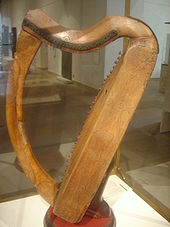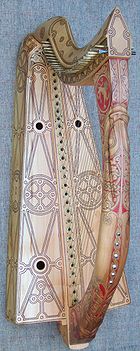
Queen Mary Harp
Encyclopedia

Clàrsach
Clàrsach or Cláirseach , is the generic Gaelic word for 'a harp', as derived from Middle Irish...
currently displayed in the National Museum of Scotland
National Museum of Scotland
The National Museum of Scotland, Edinburgh, Scotland, was formed in 2006 with the merger of the Museum of Scotland, with collections relating to Scottish antiquities, culture and history, and the Royal Museum next door, with collections covering science and technology, natural history, and world...
. It is believed to date back to the 15th century, and to have originated in Argyll
Argyll
Argyll , archaically Argyle , is a region of western Scotland corresponding with most of the part of ancient Dál Riata that was located on the island of Great Britain, and in a historical context can be used to mean the entire western coast between the Mull of Kintyre and Cape Wrath...
, in South-West Scotland
Scotland
Scotland is a country that is part of the United Kingdom. Occupying the northern third of the island of Great Britain, it shares a border with England to the south and is bounded by the North Sea to the east, the Atlantic Ocean to the north and west, and the North Channel and Irish Sea to the...
. The Queen Mary harp is a very rare and valuable survivor, as one of only three Gaelic harps to survive from medieval times, the others being the Lamont Harp
Lamont Harp
The Lamont Harp, or Clàrsach Lumanach is a Scottish Clarsach currently displayed in the National Museum of Scotland. It is believed to date back to the 15th century, and to have originated in Argyll...
and the Trinity College harp
Trinity College Harp
The Trinity College harp is a medieval musical instrument currently displayed in the long room at Trinity College Dublin. It is an early Irish harp or wire strung cláirseach...
. About 15 more survive from between 1500 and 1800 AD.
History
The Queen Mary harp http://nms.scran.ac.uk/000-190-000-742-C was presented to Beatrix Gardyn by Mary, Queen of Scots, in the 16th century, and was subsequently passed down into the Robertson family of Lude, in PerthshirePerthshire
Perthshire, officially the County of Perth , is a registration county in central Scotland. It extends from Strathmore in the east, to the Pass of Drumochter in the north, Rannoch Moor and Ben Lui in the west, and Aberfoyle in the south...
. Lady Gardyn's son had a servant in 1588 called Anthony McEwan McChlairser - 'son of the harper' - which provides a clue as to who might have played this clarsach. http://nms.scran.ac.uk/000-100-002-323-C The last harpist to play the instrument is dated as John Robertson of Lude who died c.1729; his repertory was preserved in the family and published by John Bowie in 1789. All three surviving Gaelic harps are considered to have been made in Argyll in South-West Scotland sometime in the 14th-15th century.
Appearance

Scottish Highlands
The Highlands is an historic region of Scotland. The area is sometimes referred to as the "Scottish Highlands". It was culturally distinguishable from the Lowlands from the later Middle Ages into the modern period, when Lowland Scots replaced Scottish Gaelic throughout most of the Lowlands...
grave slabs from the Argyll area, suggesting that this is the time and place that the harp originated. A grave-slab in the chapel at Keills in Knapdale
Knapdale
Knapdale forms a rural district of Argyll and Bute in the Scottish Highlands, adjoining Kintyre to the south, and divided from the rest of Argyll to the north by the Crinan Canal. It includes two parishes, North Knapdale and South Knapdale....
has a carving of a clarsach similar to the Queen Mary Harp.

